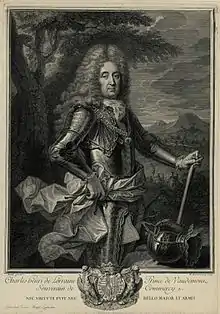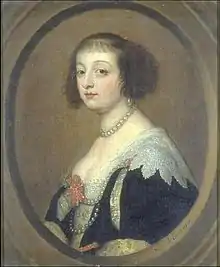Charles IV, Duke of Lorraine
Charles IV (5 April 1604, Nancy – 18 September 1675, Allenbach)[1] was Duke of Lorraine from 1624 until his death in 1675, with a brief interruption in 1634, when he abdicated under French pressure in favor of his younger brother, Nicholas Francis.
| Charles IV | |||||
|---|---|---|---|---|---|
| Duke of Lorraine | |||||
 | |||||
| Born | 5 April 1604 Nancy | ||||
| Died | 18 September 1675 (aged 71) Allenbach | ||||
| Spouse | Nicolette of Lorraine Béatrice de Cusance Marie Louise d'Aspremont | ||||
| Issue | Anne, wife of François Marie de Lorraine Charles Henri, Prince of Vaudémont | ||||
| |||||
| House | Lorraine | ||||
| Father | Francis II, Duke of Lorraine | ||||
| Mother | Christina of Salm | ||||

Life
He came to lose his duchy because of his notionally anti-French policy; in 1633, French troops invaded Lorraine in retaliation for Charles's support of Gaston d'Orléans—who repeatedly plotted against Richelieu's governance of France under the childless Louis XIII and treated dangerously with its enemies as a young heir presumptive—and Richelieu's policies were always anti-Habsburg so as to increase the strength and prestige of France at the expense of the two dynasties. Gaston d'Orléans, frequently sided with either branch of the Habsburg family against Richelieu, who was de facto ruler of France as its Chief Minister, and had to flee several times to avoid charges and trial for treason. His allies and confederates generally bore the price of these escapades by the young and impetuous heir and Charles IV was one such. On one visit to the ducal court at Nancy, the widowed Gaston fell in love with Charles's 15-year-old sister and married her secretly, which so infuriated the king that he convened the clergy of France and the Parlement of Paris to void the marriage, giving consent only on his death bed.
In that circumstance and sense, Charles was a casualty of the fierce factional infighting in the French court between the King's brother Gaston d'Orléans, and Cardinal Richelieu, even though technically, Lorraine was subject to the Holy Roman Empire and the Emperor Ferdinand II of Austria. Forced to make humiliating concessions to France, he abdicated under the French pressure and invasion in 1634 in favor of his brother, Nicholas Francis, and entered the imperial service in the Thirty Years' War and was victorious at the Battle of Nördlingen. Shortly thereafter, Nicholas Francis too fled into exile and abdicated his claims, which were now taken up once again by Charles, who remained Duke of Lorraine in exile for the next quarter century.
In 1651 Charles IV was approached by an Irish delegation who were seeking his support to defend Ireland from the invasion of the Parliamentarian army of England. Traditional accounts of the Cromwellian wars often dismiss the appeal to Lorraine as an act of desperation, but recently one historian has argued that the stateless Duke was in fact seriously interested in becoming the Protector of Ireland.[2] In the summer of 1652, a number of ships sent by Charles arrived at Inishbofin island with supplies, one of the last strongholds of the Irish. Unfortunately Charles faced great opposition by the Irish Leaders Clanricarde and Ormonde, both of whom were arch-royalists loyal to Charles II of England. Lorraine eventually concluded that Ireland had been destroyed by the jealousy of those who desired the loss of it, than they should be obliged for its recovery to the protection of his said Highness.
In 1661, the French withdrew from Lorraine, and Charles was able to return to the Duchy for the first time. In 1670, the duchy was again occupied by the French under King Louis XIV. Charles served in the Imperial armies in both the Thirty Years' War and the Franco-Dutch War (1672–1678), both of which secured French dominance on the Continent.
In 1675 he defeated François de Créquy at Konzer Brucke, and died the same year in Austrian service.
The duchy was not restored to his family until more than twenty years later.
He is sometimes numbered as Charles III of Lorraine.
Issue

Charles married first Nicolette of Lorraine, whom he deposed and replaced as monarch of Lorraine in 1625. They had no children and Charles abandoned her.
On 2 April 1637, he married Béatrice de Cusance, Princess de Cantecroix (1614-1663), daughter and heiress of Claude-François de Cusance, Baron de Belvoir (1590-1633) and of Ernestine de Witthem, Countess van Walhain, who had become the widow of Eugene Perrenot de Granvelle dit d'Oiselet, Prince de Cantecroix earlier that year; and had three children;
- Francis de Lorraine (1637 † 1638);
- Anne de Lorraine (1639 † 1720), married her cousin François Marie de Lorraine (1624 † 1694), Prince de Lillebonne in 1660, had issue;
- Charles Henri de Lorraine (1649 † 1723), Prince of Vaudémont and of Commercy.
His marriage to Béatrice de Cusance was not deemed valid by the Roman Catholic church, which had not authorised his divorce from Nicole. The couple separated in April 1642 following his excommunication, which was the consequence of his second marriage; it was also the month in which she bore a son whom Charles recognised. More than 20 years later, on 20 May 1663, Charles married Béatrice de Cusance a second time, to allow legitimation of their children. She died two weeks after this second marriage.
Charles married a fourth time at the age of 61. The bride was Marie-Louise d'Aspremont (1652-1692), the 18-year-old daughter of Charles d'Aspremont-Lynden, Count of Rekem and of Marie Françoise de Mailly. They had no children and in 1679, a widow, she married Count Heinrich Franz von Mansfeld, Prince di Fondi, by whom she had two daughters.
See also
- Dukes of Lorraine family tree
References
- Chisholm, Hugh, ed. (1911). . Encyclopædia Britannica. 5 (11th ed.). Cambridge University Press. p. 934.
- O Siochru, Micheal God's Executioner, p. 162
Sources
| Wikimedia Commons has media related to Charles IV, Duke of Lorraine. |
- The Columbia Encyclopedia, Sixth Edition
- Michael O Siochru, God's Executioner: Oliver Cromwell and the Conquest of Ireland, Faber & Faber Ltd, London, 2008
| Preceded by Nicole |
Duke of Lorraine 1625–1634 |
Succeeded by Nicholas II |
| Preceded by Nicholas II |
Duke of Lorraine 1661–1675 |
Succeeded by Charles V |
